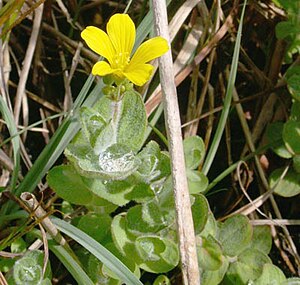Marsh wort
| Marsh wort | ||||||||||||
|---|---|---|---|---|---|---|---|---|---|---|---|---|

Marsh John's wort ( Hypericum elodes ) |
||||||||||||
| Systematics | ||||||||||||
|
||||||||||||
| Scientific name | ||||||||||||
| Hypericum elodes | ||||||||||||
| L. |
The swamp St. John's wort ( Hypericum elodes ), also called swamp hard hay , is a type of plant from the genus of St. John's herbs ( Hypericum ). It occurs only in Western Europe and is rare.
description
Vegetative characteristics
The marsh St. John's wort is a perennial, herbaceous plant that reaches heights of up to 30 centimeters. The above-ground parts of the plant are hairy downy. The stems grow prostrate to ascending. The leaves are arranged opposite one another. The simple leaf blade is ovate-elliptical and hairy.
Generative characteristics
The flowering period extends from July / August to September. The inflorescence is arm-flowered. The hermaphroditic flowers are radial symmetry and five-fold with a double flower envelope. The bracts and the egg-shaped sepals show red glands on their fringed edge. The five lemon yellow petals are 6 to 8 millimeters long.
The number of chromosomes is 2n = 32.
Occurrence, socialization and endangerment
The marsh St. John's wort is an Atlantic species with a Euocean distribution. Their area is limited to northern temperate to meridional Western Europe .
In Germany it reaches its eastern border and occurs today almost only in the extreme west and northwest in Lower Saxony and North Rhine-Westphalia . Particular mention should be made of the Lower Saxony county of Bentheim with the adjacent north-west Westphalian Münsterland , as well as the Lower Rhine .
Marsh St. John's wort occurs in Central Europe very unsteadily in gappy pioneering societies on open, nutrient-poor and base-poor, sludge-free sandy and peat soils that are alternately moist to periodically flooded. Examples of this are beach litter lawns in heather ponds , ponds and ponds , rarely in or on ditches. Detailed phytosociological observations provide the kind in Igel hose providers (Association Hydrocotylo-Baldellion) and here in particular in mesotraphenten embodiments of the Association Eleocharitetum multicaulis (Allorge 1922 em R. Tx. 1937).
The strong loss of stocks and land in recent decades is attributed to drainage and nutrient input in moors . The plant is classified as “endangered” in the Red Lists of Germany and the federal states mentioned. According to the Federal Species Protection Ordinance , it is a "particularly protected species".
Sources and further information
literature
- Henning Haeupler, Thomas Muer: picture atlas of the fern and flowering plants of Germany . Ed .: Federal Agency for Nature Conservation (= The fern and flowering plants of Germany . Volume 2 ). Eugen Ulmer, Stuttgart (Hohenheim) 2000, ISBN 3-8001-3364-4 .
- Erich Oberdorfer : Plant-sociological excursion flora . With the collaboration of Theo Müller. 6th, revised and expanded edition. Eugen Ulmer, Stuttgart (Hohenheim) 1990, ISBN 3-8001-3454-3 .
- Eckhard Garve: Atlas of the endangered fern and flowering plants in Lower Saxony and Bremen. - Nature Conservation Landscape Management Lower Saxony 30 (1994). ISBN 3-922321-68-2 .
- Henning Haeupler, Peter Schönfelder : Atlas of the fern and flowering plants of the Federal Republic of Germany . - Ulmer Verlag, Stuttgart, 1988. ISBN 3-8001-3434-9 .
- Richard Pott: The plant communities in Germany. - UTB for science, Ulmer Verlag, Stuttgart, 1992. ISBN 3-8252-8067-5 .
Individual evidence
- ^ Erich Oberdorfer : Plant-sociological excursion flora for Germany and neighboring areas . With the collaboration of Angelika Schwabe and Theo Müller. 8th, heavily revised and expanded edition. Eugen Ulmer, Stuttgart (Hohenheim) 2001, ISBN 3-8001-3131-5 , pp. 663 .
Web links
- Marsh wort . In: BiolFlor, the database of biological-ecological characteristics of the flora of Germany.
- Hypericum elodes L., swamp hard hay. In: FloraWeb.de.
- Profile and distribution map for Bavaria . In: Botanical Information Hub of Bavaria .
- Distribution in the Netherlands.
- Thomas Meyer: Data sheet with identification key and photos at Flora-de: Flora von Deutschland (old name of the website: Flowers in Swabia )
- Hypericum elodes inthe IUCN 2013 Red List of Threatened Species . Posted by: RV Lansdown, 2010. Retrieved September 20, 2013.
